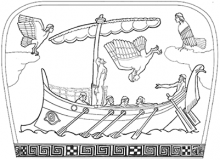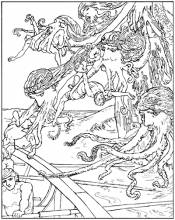
You are here
Episode 7: Torment and Trial
Story summary
Teaching activities
- Starting points
- Follow-up
- Further activities
-
More trials for Odysseus: In the land of the dead, who looked into the future and told Odysseus what he should do to break the spell of Poseidon? (Tiresias, the blind prophet.) Odysseus may be thinking that he can do what Tiresias asked, and quickly return home. But it is not so simple. We will shortly find out that when Odysseus returns to the island of Circe, dangerous new trials await him.
-
The ship: Remember what the ship was like. The men are about to do some difficult sailing. Listen carefully to see how Odysseus organises his team and explains the different jobs. He cannot afford to lose any more sailors: how many men has he lost so far?
-
Mythical creatures: Fantastic creatures and animals with strange forms are a feature of myths and often they have dangerous powers! Think back to a creature you have already met. (The Cyclops.) In this episode we will meet three more fantastic beings. As you listen, try to picture them. They are not described in depth, so add detail from your own imagination.
-
Odysseus: Think about Odysseus: what do his actions say about him? He believes he can kill Scylla and save his men, even though Circe says it is impossible; he doesn’t tell his men about Scylla; he wants to listen to the Sirens’ song although doing so puts them at risk; at the end he is the same as the men — shaking. (Is there any way that he could have saved them? Was it foolish or brave to risk their lives?)
-
Scylla, Charybdis and the Sirens: How are these different creatures described? What danger does each one represent? What details did you add from your own imagination? Scylla is also called ‘the devourer’ and Charybdis ‘the swallower’. Can you think of a similar name to describe the Sirens?
-
Between Scylla and Charybdis: This is a saying or expression (and an example of figurative language). Now you have heard the story, can you work out what it means? (In an impossible or no-win situation.) What other expressions mean the same thing? (E.g. between a rock and a hard place, between the devil and the deep blue sea.)
-
Synonyms: As they sailed towards the rocks Odysseus repeatedly asked his men to do something. What was it? (Steer towards the Sirens.) Find all the words he used for ‘asked’. (I begged them; I ordered them; I threatened them; I cursed them.) These are synonyms (they show how desperate Odysseus is; he’ll try any approach; it adds variety to the language). Think of other synonyms and use a thesaurus to find more (e.g. implored, pleaded with, beseeched). Build a bank of synonyms cards. Look for subtle differences and order the cards for shades of meaning. (Finally, learners can choose a card and in the role of Odysseus, speak to the crew in the way that the word indicates.)
-
A song so beautiful: In the song of the Sirens Odysseus heard many sounds. He describes these through images (give reminders e.g. the beating of a swan’s wing, the moan of the wind as it blows across the broad face of the world). Ask them to try saying the words out loud as expressively as they can. Point out examples of onomatopoeia and alliteration. (Think of more images for beautiful sounds, and together compose lines to turn the list into a poem. Use onomatopoeia and alliteration. Focus on the sound of the words as you speak them.)
-
![[pdf] [pdf]](/sites/default/files/pdf_icon.png) Map: Put the tower and rocks on in the sea — add the Sirens, Scylla and Charybdis.
Map: Put the tower and rocks on in the sea — add the Sirens, Scylla and Charybdis. -
Lost lives: Odysseus had already lost some men. How many and when? (4 to the Cyclops.) Now he has lost 6 more. How will this make the journey more difficult? (Fewer sailors and oarsmen.)
ICT — Create a mythical beast: This activity results in using computer graphics and text to create a new mythical beast.
The illustrations ![]() Odysseus and the Sirens and
Odysseus and the Sirens and ![]() Scylla show how mythical creatures have been pictured, by different artists at different times. It is interesting to compare the two illustrations. The Sirens are treated in a simple and stylised manner. The shape and pattern seem important. They don’t seem to really move. Do they actually look very frightening? The illustration of Scylla is action-packed and full of movement. Think about how this is achieved. We can see what has already happened and we are holding our breath knowing that another sailor is about to be caught.
Scylla show how mythical creatures have been pictured, by different artists at different times. It is interesting to compare the two illustrations. The Sirens are treated in a simple and stylised manner. The shape and pattern seem important. They don’t seem to really move. Do they actually look very frightening? The illustration of Scylla is action-packed and full of movement. Think about how this is achieved. We can see what has already happened and we are holding our breath knowing that another sailor is about to be caught.
How did you imagine them when you listened? Research websites and find more illustrations of mythical or fantastic beasts. Now invent your own.
(Explore different visual effects in a graphics program. Use them to create a new beast. Compose text to describe why your beast is dangerous.)
Visual aids
Odysseus and the Sirens
Based on an Attic stamnos (pot), late 6th-early 5th century BC, British Museum, London
The three sirens seek to lure Odysseus and his companions to their death with their melodic voices. However, Odysseus has had himself securely bound to the mast of his ship while his companions row on fast with their ears stopped with bees-wax, thus unable to hear the sirens’ song.
Suggested activities
See also teaching activities for Episode 7.

Scylla
Based on L’Odyssée d'Homère gravée par Reveil d'après les compositions de John Flaxman (Paris, 1835)
Odysseus had been warned by Circe of the two monsters Scylla and Charybdis. Scylla, darting forth her snaky heads, caught six of Odysseus’ men and bore them away shrieking to her den. Odysseus (not shown in this image) was unable to offer any assistance, instead he urged his remaining men to press on, since more men would be taken the longer they delayed. Notice that the ‘snaky’ heads of Scylla are in fact portrayed with octopus tentacles here, rather than snakes.
Suggested activities
For teaching ideas see notes for Episode 7.
